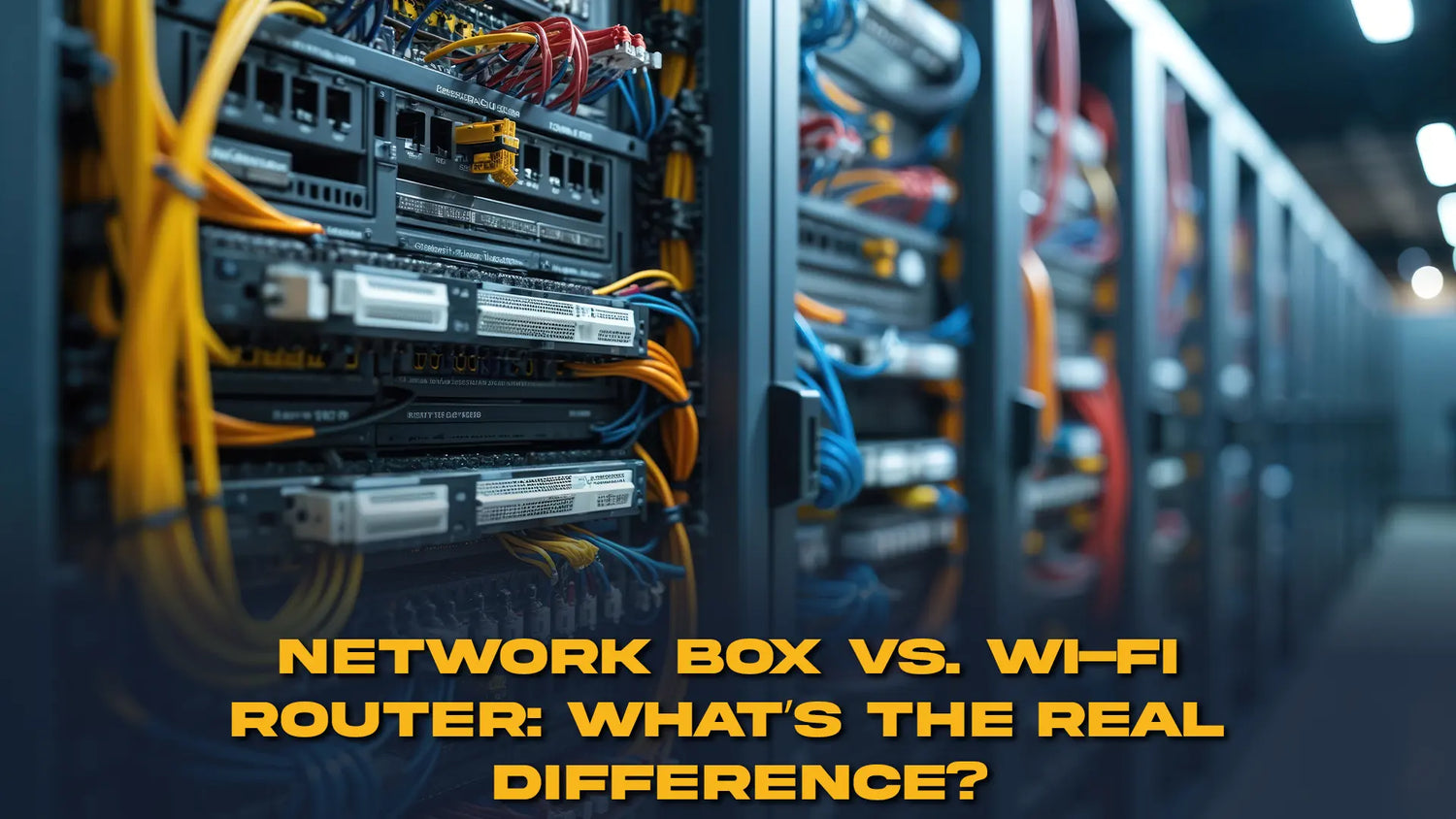Many people view a box network as a synonym for a Wi-Fi router, assuming they are really just two different names for the same thing. Which indeed would be true in an internet setting, and yet these two pieces of equipment serve two different ends and have two different strengths. Understanding the difference will surely help you make the right decision for your home or business network.
Hence, in this guide, we will be covering the basics first: What is a network box? How does it work? Then we will explain how it is different from a Wi-Fi router, and what ranges of prices are to be expected, and finally, we will furnish some tip-top tricks to set it up. When you finish reading this, you will quite clearly know what to go for, whether it is just one or preferably both, to arrive at your most stable and secure connection.
What Is a Network Box?
The device is a piece of hardware acting as an internet connection hub for your residence or office. An ISP generally provides it so that it can distribute the internet signal to multiple devices. It may serve multiple applications through one piece of hardware while a simple Wi-Fi router does not: routing/firewall protection, or sometimes firewall combined with modem capabilities.

Usually, when people ask about this device, they're referring to the model popularized by Google Fiber, but the term can apply to similar products offered by other ISPs as well. These units usually connect to your modem (or sometimes have one built in) and then provide plenty of wired and wireless connections. With security being a heavy focus for some models, their features often include built in firewalls and parental controls, making them ideal for families that want to protect their online activities without buying separate equipment.
The number one advantage this type of device offers is ease of use. Instead of buying your router, firewall, and possibly even a modem and configuring them all separately, you simply have one small device to set up—easy to install and often fully compatible with your ISP’s network.
How a Network Box Works?
To fully understand the distinction between a network box and a Wi-Fi router, one must first understand the network box itself. At its most fundamental interpretation, the network box acts as an intermediary device sitting between your internet connection and the appropriate devices. Once it has captured the signal from the ISP, whether through direct fiber, cable, or DSL, it processes the signal and routes it to the various devices in your home. Our internal workings include at least some routing software and hardware acceleration to utilize data flow effectively. It can prioritize specific traffic, prevent bottlenecks, and keep a steady connection when multiple users are online. For instance, if somebody at your place is halfway through streaming a movie, while at the same time somebody else is playing an online game, the network box balances the bandwidth to cut off lag. Another essential feature of how a network box works is security. Many brands are equipped with automatic firmware updates, intrusion detection, and advanced firewall capabilities. They keep your connected devices safe from malware, hacking attempts, and unauthorized access. This is probably one of the advantages of having a network box against a conventional router for most.
Small Network Box: Compact Yet Powerful
The small size network box can be a real boon for those living in the city in flats, small houses, or shared living arrangements. Its design consumes very little space yet offers the very same performance as the bigger models. Smaller boxes come in handy when one does not have any room for large networking equipment.

Besides their size, small network boxes are usually energy saving devices. That means less power wasted, which can be great for your electricity bill and, of course, the environment. They also tend to keep the cooler temperature, which helps the device live longer.
The small network means no compromise will be there for performance. In fact, many compact models incorporate all of the sophisticated features Gigabit Ethernet ports, dual-band Wi-Fi configurations, and multi-layer security schemes- that their larger brethren provide. The difference is in looks only, so they stand perfect for minimalistic and space-oriented environments.
Network Box vs Wi-Fi Router Differences
In essence, when we consider the network box versus Wi-Fi router differences, we are actually presenting two devices with overlapping yet distinct functionalities. A network box tends to be one multifunctional device that may route, firewall, and in some cases, even modem. The Wi-Fi router primarily provides a wireless internet connection to devices within its coverage range.
In essence, network boxes generally differ from Wi-Fi routers in that they are usually assigned to work with a particular ISP service, whereas Wi-Fi routers can be bought in any store that sells electronics and can be put into use with pretty much any Internet plan. In other words, a router may give you flexibility, but it makes life easy for a network box in setting up and maintenance, especially if configuration by your provider is not an issue.
Then it comes down to performance. High end Wi-Fi routers do offer great speeds and nice coverage, whereas a network box sometimes includes built in QoS settings that give priority to certain types of traffic, such as streaming traffic and gaming traffic, to make for a better user experience.
Network Box Price: What to Expect
Depending upon the brand, features, and provision from an ISP, the network box can cost differently. Once the device is offered through your provider, it can be received with your monthly plan; however, you will be required to pay a rental fee, sometimes referred to as an 'incremental rental fee.' $10 per month is rental included; that works to $120 per annum.

When purchased outright, most consumer network boxes come with a price tag from $100 to $300. The higher end boxes with features such as enhanced security, faster speed, and extra Ethernet ports may go north of $400. The upfront cost might be too high for some, but if you plan to keep the device for long, it can prove to be a saving in the end times, in regard to avoiding paying rentals.
The price of a network box is also linked to the they offer in terms of features. Generally, models supporting the latest Wi-Fi standards, parental controls, and integrated mesh networking tend to be costlier. So, sit down and compare the cost with the features you truly need before buying.
Network Box Setup Tips
Setting up a home internet device should not be intimidating. Here are some setup tips to ensure it works well for you. First, it’s best to place the device in a central position in your home, which will help with extended Wi-Fi coverage and ensure every device receives a strong signal. Inside cabinets or near thick walls are not ideal locations, as they can interfere with the wireless signal.
Second, be sure to follow the manufacturer’s setup instructions closely. Many devices come with companion apps that guide you through the process. Use the app to configure your Wi-Fi name, password, and security settings. Immediately after setup, check for firmware updates, as these often contain important security patches.
Lastly, think long term. For multiple devices requiring a wired connection, place the unit where it will be easy to run Ethernet cables. Also, if you plan to expand your network in the future—such as adding a mesh system—choose a model that supports it from the start.
Box Network: Understanding the Term
Sometimes people think the term box network and network box are synonyms, which is not always the case. Generally speaking, one could call a box network a system in which the bulk of the networking functions are carried out by a central device, or "box." This can then be the sort of network box that an ISP provides, or a server like device at a company, or even a home media server that also routes internet traffic.
In home networking, a box network is the term used if all devices go through a main unit, be it wired or wireless. Centralized management allows you to control all your connections, security settings, and performance optimizations from one place. Besides, it's easier to troubleshoot, as you'll need to look at just one device compared with a dozen.
These distinctions between box network and traditional multi-device networking come in handy when undergoing planning for your home internet setup. Despite being convenient, box networks sometimes don't appeal to an advanced user for purposes of customizing and controlling his or her settings.
Final Thoughts: Choosing the Right Device
So, which one is better: a network box or a Wi-Fi router? It depends on your needs. For simplicity, integrated security, and ISP compatibility, a network box would be a stellar choice. It is particularly useful for those who just want to avoid juggling multiple pieces of equipment or compromise on their time doing complex configurations.
If you want to have maximum flexibility and to be free in hardware selection or even custom network setup, then a powerful Wi-Fi router might be the better choice. In fact, some users prefer the best of both worlds, relying on a network box for security and ISP integration, together with a separate router to have better control over the Wi-Fi network.
At the end of the day, it all boils down to what you prioritize when choosing between a network box and a Wi-Fi router. When you know what a network box does, the advantages of having a small network box, about how much a network box costs on average, and the best way to set up a network box, you will be able to formulate a decision that truly guarantees you fast, secure, and reliable internet at your home.




Leave a comment
This site is protected by hCaptcha and the hCaptcha Privacy Policy and Terms of Service apply.